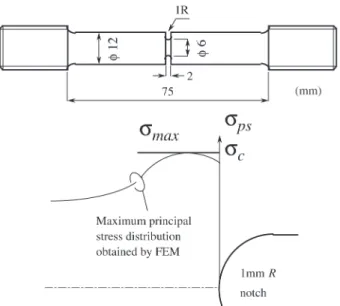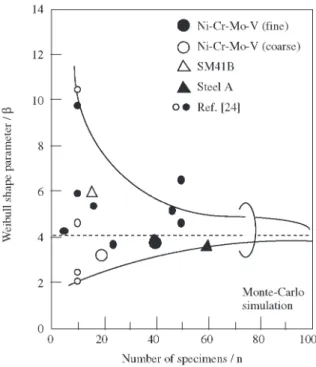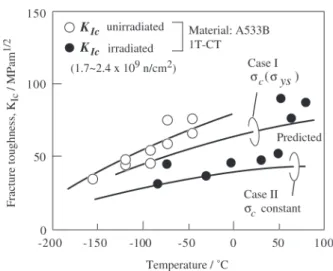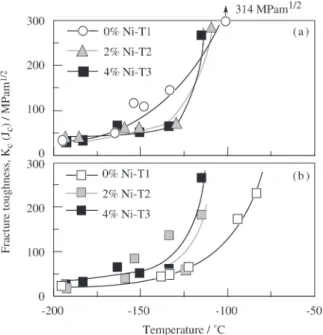Mezzo-scopic Analysis of Fracture Toughness in Steels
Takashi Miyata*, Tetsuya Tagawa
Dept. of Materials Science & Engineering, Nagoya University, Nagoya 464-8603, Japan
Received: August 28, 2001; Revised: December 29, 2001
The cleavage fracture toughness of steels was mezzo-scopically analyzed on the basis of the statistical local fracture criterion approach. The statistical stress criterion at the crack tip region suggests that the cleavage fracture toughness in steels can be described as a function of the yield stress, the cleavage fracture stress, and other mechanical properties of the materials. Formulation of the cleavage fracture toughness was first examined through an investigation on correlation between the cleavage toughness and the cleavage fracture stress obtained in notched round bar specimens in accordance with the theoretical prediction. Then, the scatter of the toughness, speci-men thickness effect on the toughness, deterioration of the toughness due to cold working and irradiation, and improvement of the toughness caused by the Ni addition, were analyzed through the formulation of the toughness.
Keywords: cleavage fracture toughness, local criterion approach, weibull stress, formula-tion of toughness, thickness effect, deterioraformula-tion of toughness, steels
1. Introduction
It is generally accepted that the transgranular cleavage fracture of steels in the transition temperature range is gov-erned by the propagation of micro-crack nucleated at car-bide particles, non-metallic inclusions and martensitic islan-ds1-4. McMahon and Cohen1 had first demonstrated that the
cracking of carbide particles at ferrite grain boundaries repre-sents a primary cleavage fracture mechanism in steels. Many authors demonstrated up to the present that brittle cleavage fracture in steels initiates at some particles that are more harder and brittle than the surrounding ferrite matrix2-8. The
cleavage fracture is promoted by factors that produce lo-cally elevated tensile stress, since tensile stress governs the propagation of a micro-crack as a Griffith crack2,5-7. The
cleavage crack once initiated can propagate with low en-ergy dispersion and results unstable propagation. It implies that the fracture obeys the Weakest Link Analogy and sta-tistical distribution of the critical fracture stress shows the Weibull distribution. Formulation of the Weibull stress cri-terion to describe the cleavage fracture of steels was first performed by Beremin9 and Mudry10.
Incorporation of local criteria to analytical or numerical solutions for stress distribution at the crack tip derives an expression of fracture toughness in terms of flow and frac-ture properties of materials as is representatively shown in RKR model11. Statistical modeling for fracture proposed by
Beremin gives more rational expression of the cleavage
frac-ture toughness because the physical nafrac-ture of the cleavage fracture is explicitly taken into account.
The cleavage fracture toughness of steels is quite sensi-tive to metallurgical factors, and it strongly depends on tem-perature, strain rate and constraint due to variation in the specimen thickness, in the notch depth and in the scale of yielding at the crack tip12,13. Degradation in the toughness
due to pre-straining, irradiation and strain aging, or so on, has been often reported. However, the factors that deterio-rate the toughness have been individually, experimentally discussed till the moment. The dislocation theory and other microscopic approach may significantly contribute for analysis on the fracture and toughness of steels, while they give little quantitative information on mechanical factors responsible to the toughness. On the other hand, the mezzo-scopic description or formulation of the toughness can be expected to give more comprehensive, more quantitative understanding of all subjects responsible to the toughness, and it may lead to the development of improvement of the toughness.
Statistical model9 was successfully applied to analyze
scatter of toughness14, increase of the toughness caused by
the loss of constraint due to shallow notch15, and applied
for qualification of the toughness16. In the present work,
simplification of the statistical model is first performed to describe the cleavage toughness of various type of steels involving a mild steel and a low alloy steel. Theoretical
de-*e-mail: abe@numse.nagoya-u.ac.jp
scription of the toughness is experimentally confirmed through a correlation between the cleavage fracture tough-ness obtained in toughtough-ness test and the yield/cleavage frac-ture strength obtained in round bar tensile test. Then, the effects of various mechanical and metallurgical factors on the toughness are discussed on the basis of the comprehen-sive formulation of the toughness. The experimental results including those reported already elsewhere are analyzed.
2. Statistical Local Fracture Criterion and
Description of Fracture Toughness
According to the 2 parameter Weibull statistics, prob-ability of failure for a certain volume of material, V sub-jected to gradient tensile stress σi is assumed to be
P=1−exp− V σi σ0 m dV V0 ∫
=1−exp σw σ0 m
(1)
where, Vo is the statistical unit volume, m and σo are the shape parameter and the scale parameter of the Weibull cleavage fracture stress, respectively9. The Weibull stress is
denoted as σω. Equation (1) can be applied to the fracture toughness specimen. With the assumption that the stress singularity at the crack tip is given in terms of normalized coordinate (r/J, r/K2) such as the HRR solution, the integral term in Eq. (1) is deduced to
V σi
m
V0 dV=
∫
σwm
=B K
σys 4 σys m
F n
(
,m,V0)
(2)where B is the specimen thickness, σys is the yield strength, n is the strain hardening exponent of materials and
F is a function of m, n and V
o. Equation (2) indicates that the fracture toughness shows statistically the Weibull dis-tribution with the constant shape parameter of 4 when the toughness is expressed in the stress intensity factor9,14,17. For
a certain failure probability, the Kc value is given by
Kc=C n
(
,m,V0)
B1/ 4 σys
σ0 σys
m/ 4
(3)
where C(m, n, Vo) is a function of n, m and Vo. Equation (3) gives a theoretical foundation for a correlation between the fracture toughness and other mechanical properties of materials. Simultaneously, Equation (3) also indicates that the variation of the toughness with temperature, strain rate, and others may be primarily governed by the variation of the yield stress of the materials since the cleavage fracture stress can be assumed to be independent of those factors18-21.
Validity of the statistical Beremin model expressed as Eq. (3) has been confirmed for the temperature dependence17
and the scatter of the toughness18. Instead of the Weibull
cleavage fracture stress, the fracture stress defined in deter-ministic terms has been adopted in the present work to con-firm the description of the fracture toughness by the local criterion approach, because it needs a great number of speci-mens to obtain the statistical Weibull parameters.
In order to investigate the correlation between the frac-ture toughness and the cleavage fracfrac-ture stress, more than 50 types low carbon structural steels including from a mild steel to a low alloy high strength steel with a yield strength of 250 MPa to 1,100 MPa, are tested. Cleavage fracture stress, σc is defined as the local maximum principle stress at the cleavage fracture initiation in round bar tensile speci-mens with 1mm radius circumferential notch as shown in Fig.1. Tensile tests were performed at the liquid nitrogen temperature and the critical stresses were calculated by the axisymmetric finite element analysis using the constitutive equation for each material. For several materials the Weibull fracture stress was also obtained from repeated tests under the same condition.
Figure 2 shows the correlation between the scale pa-rameter of the critical Weibull stress, σo and the critical frac-ture stress, σc for 13 to 20 specimens of seven types ferrite/ pearlite steels with different grain size22. Although the
Weak-est link analogy stimulates the size and geometry depend-ence of the deterministic critical fracture stress, good cor-relation between σo and σc can be observed. This result in-dicates the deterministic critical fracture stress can be rep-resentative to the statistical Weibull fracture stress.
ing to the analogy of the statistical model, fracture tough-ness can be expected to be,
Kc
( )
Jc = CmB1/ 4σc σc σys
α
= (4)
Formulation of the toughness such as in Eq. (4) had been experimentally suggested by Hahn et al.23.
Toughness tests at various temperature were carried out for the CT specimens and the three point bend specimens. The cleavage fracture toughness were evaluated in J-inte-gral and converted to the equivalent Kc values denoted as
Kc (Jc). Testing was performed in accordance with the ASTM E1820 except for the specimen size prescription. For the correlation with the critical stress, all toughness data were utilized that satisfy the condition of
B,b≥10 Jc σys
(5)
where b is the pre-crack length of the toughness speci-mens. Equation (5) seems to be lenient to obtain the valid toughness for constraint effect. However, in-plane constraint effect can be assumed to be not so large13 insofar as the
fracture toughness is discussed in the sense of accuracy in the following discussion. Specimen thickness effect was taken into account and converted to the equivalent value for 25 mm thickness from the following relation that is obtained from Eq. (4).
Kc
4B=constantK c
4
B=constant (6)
Figure 3 shows correlation according to Eq. (4) between the fracture toughness and the cleavage fracture stress ob-tained in the notched round bar tensile tests. The value of Cm
and α are materials constants, respectively, determined from the least square method to give the most high correlation co-efficient for each material. Notations of M, BU, BL, F&P indi-cate micro-structure of materials, that is, martensite, upper bainite, lower bainite, and ferrite/pearlite, respectively. M* indicates the martensitic islands. Good correlation can be observed and the validity of formulation as Eq. (4) has been confirmed. The value of the materials constant Cm can be assumed theoretically and experimentally to be not so sensi-tive to the material. Assuming a constant value of Cm irre-spective of the materials, a correlation was again investigated as shown in Fig. 4. Almost similar correlation as in Fig. 3 can be obtained and is expressed for the mean value as
Kc
(
MPam1/ 2)
=2.85×10
−3
B(mm)1/ 4 σys(MPa) σc σys
α
(7)
Examples of the temperature dependence of the frac-ture toughness are shown in Fig. 5 and solid lines indicate predicted values from the notched round bar specimens ac-cording to Eq. (7). The value of exponent α may be related to the statistical characteristics of micro-crack nuclei as is
presumed from the Beremin Model 9. Figure 6 shows the
values of α for each material in relation with the transition temperature of the fracture toughness at which the tough-ness takes the value of 150 MPam1/2. The values of α are in
the range from 3.5 to 5.0, and show general tendency that
Figure 2. Relation between σc and σo for ferrite/pearlite steels with different grain size22.
5. Thickness effect on the fracture toughness
The size effect on the cleavage fracture toughness for a fine grained Ni-Cr-Mo-V steel had been rigorously
investi-gated by the JSPS Committee 12924. The mean values of
the toughness for a lot of specimens are shown in Fig. 7 in relation to the specimen thickness. All other dimensions of the toughness specimens are proportional to the thickness. Predicted value from Eq. (6) is also shown as a fine solid line. Although the stress state in the thickness direction is varied from the plain strain in the mid-thickness region to the plane stress in the specimen surface, volume effect strictly in accordance with Eq. (6) can be observed. The statistical local approach on the basis of the two parameters Weibull statistics does not give a lower saturation in the size effect. The values of Kc obtained by specimens which satisfy the plane strain condition given in the ASTM Stand-ard, might be regarded as the plane strain fracture tough-ness, KIc 25 as is given in Fig. 7.
6. Scatter of the fracture toughness
As is presumed from Eq. (2), statistical local fracture criterion approach suggests that the statistical distribution of the cleavage fracture toughness of steels is expected to be the Weibull distribution with a constant shape parameter of 4. Figure 8 shows the Weibull plots of the fracture tough-ness of a fine and a coarse grained Ni-Cr-Mo-V steel, a mild steel (SM41B), and a high strength steel embrittled with martensitic islands (Steel A). The Weibull shape pa-rameter, β are given in the figure. It should be noticed that the values of shape parameter are not so varied with
materi-Figure 4. Relation between fracture toughness and cleavage frac-ture parameter obtained by round bar specimens in accordance with Eq. (7).
the materials with inferior toughness and higher transition temperature have low values of α.
4. Influential Factors on the Fracture
Toughness and its Analysis
According to the formulation expressed in Eq. (7), the influence of various factors on the fracture toughness can be quantitatively presumed. Several factors that have an in-fluence on the toughness shall be discussed.
Figure 5. Temperature dependence of fracture toughness for low carbon steels.
Figure 6. Variation in espoent α with transition temperature for all steels tested.
als. The shape parameters are shown in Fig. 9 as a function of number of specimens tested, together with other experi-mental data24. The solid lines in the figure show results of
the Monte-Calro simulation with an assumption of constant shape parameter of 4. Although the experimental results involve several data set with a little amount of ductile crack growth preceding the cleavage fracture, the experimental results are well consistent with the theoretical prediction in Eq. (2).
7. Deterioration of the toughness due to
pre-straining
Pre-straining or cold working deteriorates the cleavage fracture toughness of steels, and degree of deterioration
seems to be dependent on materials26,27. Small amount of
pre-straining doesn’t have any influences on the cleavage fracture stress as is shown in Fig. 1022. Figure 10 shows
experimental results on the effect of pre-strain on the yield stress and the cleavage fracture stress of two low carbon steels. Provided that the cleavage fracture stress, σc and ex-ponent α in Eq. (7) are not varied with the pre-straining, the deterioration in the toughness is approximately obtained from
Kcpre−strain
Kc virgin =
σysvirgin σyspre−strain
α
(8)
Figure 11 shows examples of experimental results on the toughness deterioration due to the cold working. The material tested is a 500 MPa class high strength steel and the pre-strain in terms of equivalent strain was given by cold rolling. Pre increase in the yield strength by the pre-strain can be estimated from the constitutive equation of the virgin material. Two solid lines in the figure show pre-dicted value of the toughness from experimental results on toughness and mechanical properties of the virgin material. Equation (8) indicates that the deterioration in toughness due to the pre-straining is strongly dependent on the strain hardening of materials and the exponent α which is related to the statistical distribution of micro-crack nuclei. An
ex-Figure 7. Effect of specimen size on fracture toughness24
(fine-grained Ni-Cr-Mo-V steel, -20 °C).
Figure 8. Weibull distributions of fracture toughness.
perimental result that the yield ratio of materials has sig-nificant influence on toughness deterioration has been shown elsewhere22.
8. Deterioration of the toughness due to
irradiation
Analogy in deterioration of the toughness due to the pre-straining is applicable to the irradiation embrittlement. The neutron irradiation causes increase of the yield strength of steels. Figure 12 shows an experimental result on the
dete-rioration due to the irradiation 28 and its prediction
accord-ing to Eq. (7). Since it can be assumed that metallurgical factors such as micro-structure and carbide size/distribu-tion are not varied with the irradiasize/distribu-tion, the exponent α in Eq. (7) is considered kept constant. With two assumptions for the cleavage fracture stress the deterioration in tough-ness can be predicted as shown in Fig. 12 from the experi-mental results on hardening due to the irradiation. The cleav-age fracture stress was assumed to be proportional to the increase of the yield strength (Case I) or to be constant (Case II).
9. Improvement of the toughness with the
increase of Ni contents
It is well known that nickel is one of the most effective alloy elements to improve the fracture toughness of low carbon steels. On the other hand, the detrimental effect of Ni is also observed depending on cooling rate at the tem-pering. There are many mechanisms to explain the tough-ness improvement owing to the nickel addition. One of ra-tional mechanisms is that the nickel addition restrains the increase of the yield strength at low temperature range29. It
seems to be rational in accordance with Eqs. (3) and (7), while the deterioration can not be explained. Experimental results on both improvement and deterioration in toughness30
shall be introduced in the present paper.
The chemical compositions of materials tested and ther-mal cycles of heat treatments, are shown in Table 1 and Fig. 13, respectively. Thermal cycles were selected to keep the micro-structure be the same as upper bainite for the materi-als with different Ni contents. The same thermal cycle was
Figure 10. Tensile properties of steels tested as a function of the pre-strain22.
Figure 11. Deterioration of fracture toughness due to cold work-ing.
Figure 13. Thermal cycles subjected to steels tested.
Figure 14. Temperature dependence of fracture toughness for the steels tested. (a) Steels with the same microstructure; (b) Steels subjected to the same heat treatment.
equivalent Kc values. In case that the micro-structure is the same, Ni addition leads to inferior toughness, while in case of the same thermal cycle improvement of the toughness is achieved. This apparent discrepancy is caused from oppo-site effect of Ni on the cleavage fracture stress. Figure 15 shows the effect of Ni contents on the yield strength and the cleavage fracture stress, σc obtained in the round bar tensile specimens. The effect of Ni contents on σc is contrary de-pending on the micro-structure and consistent with the toughness variation. Although discussion on detail from the metallurgical point of view is not objectives of the present work, the cleavage fracture stress is governed by the size of simultaneously applied regardless of different Ni contents,
that caused different micro-structure.
Fracture toughness testing and notched round bar ten-sile test were performed for each steels. The results on the fracture toughness test are shown in Fig. 14. The toughness values are converted from Jc values evaluated in the test to
Figure 15. Effect of Ni contents on yield strength and cleavage fracture strength of the steels tested.
Table 1. Chemical compositions of steels tested for investigation of the effect of Ni contents (mass%).
C Si Mn P S Al N Ti Ni
0% Ni 0.074 0.22 0.77 0.005 0.003 0.028 0.004 0.009
-2% Ni 0.074 0.22 0.76 0.005 0.004 0.030 0.002 0.009 1.97
second phase hard particles and flow properties of the ma-trix (dislocation mean free path)30. Correlation between the
toughness and the cleavage fracture parameter in accord-ance with Eq. (7) was investigated as shown in Fig. 16. The results indicates that both the improvement and the deterio-ration in toughness due to the addition of Ni can be com-prehensively explained through the formulation of the tough-ness.
10. Conclusions
Formulation of the cleavage fracture toughness of steels was examined on the basis of the statistical local fracture criterion. The Weibull stress criterion model proposed by Beremin Group derives a description of the toughness in terms of fracture and mechanical properties of materials. Experimental results in notched round bar specimens dem-onstrate that the critical Weibull stress for the cleavage ture can be represented with the deterministic critical frac-ture stress defined as the maximum tensile stress at the cleav-age fracture. Based on this result correlation between the cleavage toughness and the critical fracture stress was in-vestigated for more than 50 types of steels in accordance with the analogy of the statistical Beremin model.
Experimental results were well consistent with the theo-retical prediction. Simultaneously, experimental results on the scatter of the toughness and on the specimen thickness effect on the toughness confirmed the validity of the model. The description of the toughness could show us compre-hensive understanding on the elements which compose the
Figure 16. Correlation between fracture toughness and cleavage fracture parameter.
cleavage toughness. Deterioration of the toughness due to pre-straining and irradiation were well explained with the increase of the yield strength. The toughness is in inverse proportion to the αth power of the yield strength. Tempera-ture and strain rate dependence of the toughness may be also explained with the variation of the yield strength of the materials.
Representatively the effect of the Ni contents on the cleavage toughness was investigated through the formula-tion of the toughness. It was clarified that the improvement and deterioration both are possible depending on the effect of the Ni on the cleavage fracture stress in spite of the de-crease in the yield strength at low temperature region.
It should be conclusively noticed that the effect of these mechanical and metallurgical factors on the toughness is presumed to be differently dependent on materials except for the thickness effect, since the value of α might be gov-erned by the statistical nature of the micro-crack nuclei.
References
1. MacMahon, C.J.; Cohen, M. Acta Metall., v. 13, p. 591, 1965.
2. Smith, E. Proc. Conf. Physical Basis of Yield and Frac-ture, Physical Soc. of Oxford, p. 36, 1966.
3. Knott, J.F. J. Iron and Steel Inst., 204, p. 104, 1966. 4. Hahn, G.T. Met. Trans., A15, p. 947, 1984.
5. Knott, J.F. Fracture ’77, Proc. 4th ICF, v.1, p. 61, 1977.
6. Curry, D.A.; Knott, J.F. Metal Sci., v. 13, p. 341, 1979. 7. Petch, N.J.; Armstrong, R.W. Acta Metall., v. 34, p. 1121,
1986.
8. Aihara, S.; Haze, T. TMS Annual Meeting, Phoenix, AZ, Jan.25-28, paper No. A88-14, 1988.
9. Beremin, F.M. Met. Trans., A14, p. 2277, 1983. 10. Mudry, F. Nuclear Eng. and Design, v. 105, p. 65, 1986. 11. Ritchie, R.O.; Knott, J.F.; Rice, J.R. J. Mech. Physics of
Solids, 21, p. 395, 1973.
12. O’Dowd, N.P.; Sih, C.F. J. Mech. Physics of Solids, v. 40, p. 939, 1992.
13. Anderson, T.L.; Dodds, R.H. J. Testing and Evaluation, v. 19, p.123, 1991.
14. Wallin, K. Eng. Fracture Mechanics, v. 19, p. 1085, 1984. 15. Ruggieri, C.; Minami, F.; Toyoda, M.; Hagiwara, Y.; Inoue, T. J. Soc. Naval Architects of Japan, n. 171, p.493, 1992.
16. Miyata, T.; Tagawa, T.; Yang, H. J. Testing and Evalua-tion, v. 28, p. 62, 2000.
17. Pineau, A. Advances in Fracture Research, Proc. of ICF5, v. 2, p. 553, 1981.
18. Knott, J.F. Fundamentals of Fracture Mechanics, Butter-worth, London, p. 180, P201, 1973.
21. Curry, D.A. Metal Sci., 16, p. 435, 1982.
22. Miyata, T.; Tagawa, T. J. de Physique IV, Colloque C6, v. 6, p. 235, 1996.
23. Hahn, G.T.; Hoagland, R.G.; Rosenfield, A.R.
Metal-lurgical Trans., v. 2, p. 537, 1971.
24. Japanese Soc. for Promotion of Sci., Committee 129, Report on Round Robin Test on the Fracture Tough-ness in Transition Temperature Region, 1985.
25. Miyata, T.; Otsuka, A.; Katayama, T.; Otake, T. Defect Assessment in Components – Fundamentals and
Appli-cation, ESIS/EGF9(edited by Blauel, J.G., and Scwalbe, K.H.), Mechanical Engineering Publication, p. 501, 1991. 26. Terasawa, K.; Ohtani, M.; Yoshida, T.; Terai, K. J. Soc.
Naval Arch. Japan, 109, p. 317, 1961.
27. Groom, J.D.G.; Knott, J.F. Metal Sci., 19, p. 390, 1975. 28. Hunter, C.W.; Williams, J.A. Nuclear Eng. and Design,
17, p.131, 1971.
29. Jolley, W. Trans. AIME, 242, p. 306, 1968.





